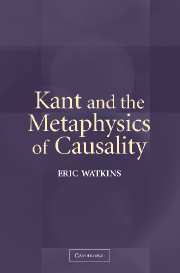PART I - CAUSALITY IN CONTEXT
Published online by Cambridge University Press: 12 January 2010
Summary
The first part of this study presents the historical context to Kant's Critical views on causality. Chapter 1 (“Pre-established Harmony versus Physical Influx”) discusses how the issue of causality was understood and developed in response to changing intellectual conditions in Germany in the first half of the eighteenth century by figures such as Leibniz, Wolff, Knutzen, Baumgarten, Meier, and Crusius. Chapter 2 (“Kant's Pre-Critical Theory of Causality”) investigates how Kant reacted to this context and developed an increasingly independent position on the issue of causality throughout his pre-Critical period. These two chapters, taken together, provide the proper historical background for attaining an accurate understanding of Kant's views on causality in the Critical period, the subject of the second part of this study.
Information
- Type
- Chapter
- Information
- Kant and the Metaphysics of Causality , pp. 21 - 22Publisher: Cambridge University PressPrint publication year: 2004
